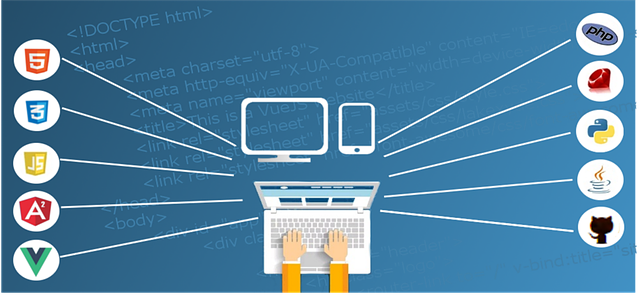High-level understanding of the various components that make up full-stack web development is important on the path to full-stack web development. This includes understanding the difference between front-end development, which focuses on the user interface and user experience of a website, and back-end development, which involves the server-side programming that powers the website.
Once a basic understanding of web development concepts is achieved, the next step is to create a roadmap for learning. This roadmap should include a list of topics that need to be covered, as well as an estimate of the time and resources needed to learn each topic. It is also important to set realistic goals and deadlines for each stage of the learning process.
An intelligent web programmer will intend to learn web development quickly, and for that, it is essential to leverage the best resources available. This includes online courses, tutorials, and other educational resources that can be accessed from anywhere. Additionally, it is helpful to join online communities and forums where web developers can share knowledge and insights, and to attend conferences and events where web development experts share their knowledge and experience.

Ultimately, learning web development is a continuous process that requires dedication, effort, and persistence. However, the benefits of having this skillset are numerous, and can significantly improve a learner’s ability to build and scale a successful business.
Let’s understand the basic factors that one must need to understand fully in order to become a full-stack developer.
Learning HTML/CSS/JS
The best place to begin leaning web development is by understanding the three main technologies that all websites are made of. The first technology is HTML, which stands for Hypertext Markup Language. HTML defines the content of a website, such as text, images, and video, and organizes it into a logical structure. HTML is the foundation of every website, and without it, a website cannot exist.
The second technology is CSS, which stands for Cascading Style Sheets. CSS is responsible for specifying how a website looks, including fonts, colors, images, and other visual elements. CSS allows web developers to create visually appealing websites that are easy to navigate and use.

The third technology is JavaScript, which is a programming language that allows you to dynamically manipulate elements on a web page. This means that all the interactive elements you see on the internet, such as dropdown menus, sliders, and pop-up windows, are made using JavaScript.
Motivation to learn web development will lead you to a solid understanding of HTML, CSS, and JavaScript, you can start exploring more advanced topics such as web frameworks, databases, and server-side programming. With dedication and hard work, anyone can become a skilled web developer and begin working on amazing web development projects.
Learning Frameworks
Becoming a full stack developer requires a wide range of skills and expertise. In addition to understanding the fundamental technologies that websites are built with, such as HTML, CSS, and JavaScript, it is also essential to learn the frameworks that are used to implement common functionality much faster and more easily.
App development frameworks are collections of pre-written code that help developers build websites or web applications faster and more efficiently. They provide a set of tools and best practices that can be used to streamline the development process and reduce the amount of time and effort required in the process.
Bootstrap and jQuery are two of the most popular and widely used frameworks in web development. Bootstrap is a front-end framework that provides a collection of CSS and JavaScript components that can be used to create responsive and mobile-first websites. It includes pre-built styles for typography, forms, buttons, and navigation, as well as JavaScript plugins for modal windows, carousels, and other interactive elements.
jQuery is a JavaScript library that simplifies the process of writing JavaScript code by providing a set of pre-built functions and methods. It makes it easier to select and manipulate HTML elements, handle events, and create animations and effects. jQuery is widely used in web development because it simplifies common tasks and reduces the amount of code that developers need to write.
Learning Bootstrap and jQuery is an excellent place to start for anyone who wants to become a full stack developer. These frameworks are widely used and have a large community of developers who contribute to their development and maintenance. By mastering these frameworks, you can streamline your development process, build more complex and dynamic websites, and become a more skilled and valuable web developer.
Learning WordPress
When it comes to building websites, WordPress is one of the most popular and widely used content management systems in the world. Understanding WordPress is essential for anyone who wants to create an easily customizable website quickly and efficiently.
WordPress is a powerful and flexible platform that allows users to create a wide range of websites, from simple blogs to complex e-commerce sites. It provides a user-friendly interface that makes it easy for non-technical users to manage their website content, including text, images, and multimedia.

One of the main benefits of using WordPress is its vast collection of themes and plugins. Themes are pre-built templates that can be used to customize the design and layout of a website, while plugins are add-ons that provide additional functionality such as contact forms, social media integration, and search engine optimization. With thousands of free and premium themes and plugins available, WordPress makes it easy to create a unique and customized website that meets your specific needs. People often opt for custom WordPress development services in case they are not familiar with it. If you fall in with the same scenario, you can do it too. But if you are someone looking to learn WordPress it from the scratch, then there are a lot of resources available online to start with.
Learning Domain Names and Hosting
Once you have learned the basics of full stack development and have built your first website, the next step is to make it available to the world. This involves understanding the concepts of domain names and web hosting.
A domain name is the address that people use to access your website. It is essentially the name that you give to your website and it is used to identify and locate it on the internet. When you register a domain name, you are essentially renting the right to use that name for a specified period of time.
Web hosting, on the other hand, is the service that allows you to store your website files and make them available to visitors on the internet. When you sign up for a web hosting service, you are essentially renting space on a server where your website files can be stored and accessed by visitors.

Choosing a domain name and a web hosting provider can be a daunting task for beginners, but there are many resources available online that can help you make the right choices. You will need to consider factors such as the cost, reliability, and performance of the hosting service, as well as the availability and suitability of domain names.
Once you have registered your domain name and signed up for a web hosting service, you can then upload your website files to the server and make your website available to the world. It’s important to choose a reliable and secure web hosting provider and to regularly back up your website files to ensure that your website remains accessible and protected from data loss.
Learning Backend Frameworks
When it comes to becoming a full stack developer, learning a backend framework and the technologies used for backend development is an essential step. Backend frameworks are powerful tools that allow developers to build complex web applications that run on a server and dynamically generate HTML for a website every time a user visits a URL.
There are many different backend frameworks available, but three of the most popular and widely used are Django, Ruby on Rails, and Node/Express. Each of these frameworks has its own unique strengths and weaknesses, and the best choice for you will depend on your specific needs and preferences.
Django is a Python-based framework that is known for its ease of use and its robust set of features. It is designed to help developers build complex web applications quickly and efficiently, and it has a strong community of developers who provide support and guidance to newcomers.

Ruby on Rails is a popular framework for building web applications using the Ruby programming language. It is known for its elegant and intuitive syntax, as well as its emphasis on convention over configuration. Ruby on Rails is a great choice for developers who value simplicity and productivity.
Node/Express is a popular backend framework for building web applications using the JavaScript programming language. It is known for its speed and scalability, as well as its ability to handle large volumes of traffic. Node/Express is a great choice for developers who are already familiar with JavaScript and want to build fast, responsive web applications.
Learning a backend framework is an important step in becoming a full stack developer, and it can be a challenging but rewarding experience. There are many resources available online to help you get started with each of these frameworks, including tutorials, documentation, and forums. By mastering one of these powerful tools, you can take your web development game on another level.
Leaning Frontend Frameworks
To take your web development skills to the next level and become a full-stack developer, familiarity with frontend frameworks is necessary. These frameworks are designed to simplify the process of building responsive, interactive, and dynamic user interfaces, allowing developers to focus on functionality and design rather than low-level implementation details.
Frontend frameworks like React, Angular, and Vue have become increasingly popular in recent years due to their ability to simplify the development process and provide a robust set of tools for creating modern web applications. By mastering these frameworks and integrating them with your existing skills, you can take your web development abilities to the next level and create even more sophisticated and innovative web applications.
Leaning DevOps
Becoming a Full-Stack Web Developer requires an extensive skill set that includes not only knowledge of frontend and backend development but also the ability to manage the deployment and maintenance of web applications. This is where DevOps comes in.
DevOps refers to the set of practices and tools used to streamline the process of software development and deployment, including continuous integration and delivery (CI/CD), infrastructure management, and automated testing. While DevOps is a deep subject that requires expertise in a range of areas, the fundamentals of deploying websites are not that hard to understand.
To become proficient in DevOps, it is essential to understand the basics of server management, networking, and security. This includes knowledge of tools such as Docker, Kubernetes, AWS, and other cloud computing platforms that are commonly used in modern web development. By mastering these tools and techniques, Full-Stack Web Developers can deploy web applications with ease and ensure that they are scalable, reliable, and secure.
While it may seem daunting to learn yet another set of skills, becoming proficient in DevOps is an essential step for any Full-Stack Web Developer looking to take their skills to the next level. By understanding the fundamentals of deployment and maintenance, developers can create robust, efficient, and scalable web applications that meet the needs of modern businesses and users.
Conclusion
In conclusion, becoming a Full-Stack Web Developer is a challenging but rewarding journey. To achieve success, one must have a strong foundation in HTML, CSS, JavaScript, and at least one backend framework. Additionally, proficiency in frontend frameworks such as React, Angular, or Vue, as well as DevOps practices, is essential to become a well-rounded Full-Stack Developer.
By mastering these skills and continuously learning and staying up-to-date with the latest technologies and trends, Full-Stack Web Developers can create complex and innovative web applications that meet the needs of modern businesses and users. With the increasing demand for skilled Full-Stack Developers in the job market, investing time and effort in becoming proficient in this field is a wise choice for anyone looking to pursue a career in web development.
Moreover, if you are looking forward to join as an intern in a Web Development Company to become a full stack developer, Accrete is the right choice for you. Also if you are looking to hire a web development company that provides world class full stack development services, then also Accrete Infosolution Technologies is the one stop solution for you.